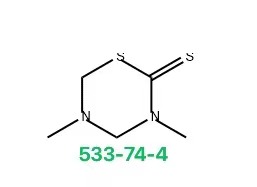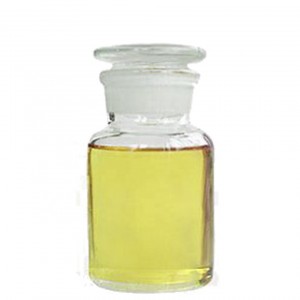-

N-Ethyl-N-hydroxyethylaniline CAS: 92-50-2
m-Tolyldiethanolamine,also known as DEET (diethylamide N,N-dimethyl-3-hydramide), is a common insect repellent. It is soluble in organic solvents such as ester, alcohol, and ether, and slightly soluble in water. This compound has good heat resistance and light resistance.
m-Tolyldiethanolamine is mainly used as an insect repellent to prevent bites and harassment from mosquitoes, ticks, fleas, grasshoppers and other insects. Its efficacy lasts for a long time and has a high repellent effect on mosquitoes and other insects. It is widely used in outdoor activities, wilderness exploration and military protection and other fields.
There are many methods for preparing N,N-bishydroxyethyl m-toluidine. One of the commonly used methods is to react m-toluidine and formamide in the presence of an alkaline catalyst. Specific steps are as follows:
1. React formamide with m-toluidine under alkaline conditions to generate N-formyl m-toluidine.
2. Heat the reaction product under acidic conditions to convert N-formyl m-toluidine into N,N-bishydroxyethyl m-toluidine. -

m-Tolyldiethanolamine CAS: 91-99-6
m-Tolyldiethanolamine,also known as DEET (diethylamide N,N-dimethyl-3-hydramide), is a common insect repellent. It is soluble in organic solvents such as ester, alcohol, and ether, and slightly soluble in water. This compound has good heat resistance and light resistance.
m-Tolyldiethanolamine is mainly used as an insect repellent to prevent bites and harassment from mosquitoes, ticks, fleas, grasshoppers and other insects. Its efficacy lasts for a long time and has a high repellent effect on mosquitoes and other insects. It is widely used in outdoor activities, wilderness exploration and military protection and other fields.
There are many methods for preparing N,N-bishydroxyethyl m-toluidine. One of the commonly used methods is to react m-toluidine and formamide in the presence of an alkaline catalyst. Specific steps are as follows:
1. React formamide with m-toluidine under alkaline conditions to generate N-formyl m-toluidine.
2. Heat the reaction product under acidic conditions to convert N-formyl m-toluidine into N,N-bishydroxyethyl m-toluidine. -

Triethylene glycol CAS: 112-27-6
Triethylene glycol CAS: 112-27-6
It is a colorless, odorless, hygroscopic, viscous liquid. Miscible with water and ethanol, slightly soluble in diethyl ether, almost insoluble in petroleum ether.
Used as an excellent dehydrating agent for natural gas, oil field associated gas and carbon dioxide; used as a solvent for nitrocellulose, rubber, resin, grease, paint, pesticides, etc.; air disinfectant; polyvinyl chloride, polyvinyl acetate resin, glass fiber and triethylene glycol lipid plasticizers for asbestos pressed boards; tobacco anti-drying agents, fiber lubricants and natural gas desiccants; also used in organic synthesis, such as the production of brake oil with high boiling point and good low temperature performance。
It is also used as gas chromatography stationary solution and solvent for nitrocellulose and various resins. It is also used in organic synthesis. -

Dazomet CAS:533-74-4
Dazomet CAS:533-74-4
Chemical properties: The pure product is white needle-like crystal, odorless, m.p. 99.5℃ (decomposition) (104~105℃). Vapor pressure 400×10-6Pa. Easily soluble in acetone and chloroform; slightly soluble in ethanol and benzene; chemically insoluble in ether and carbon tetrachloride; solubility in water at 25°C is 0.12%, and solubility in warm water is slightly improved. It is easy to decompose in aqueous solution, and the decomposition is accelerated when the temperature is above 45°C, which affects the effect of the agent; it is easy to decompose when encountering strong acid and strong alkali.
Broad-spectrum pesticide. Nematicides with fumigation effect decompose methyl isothiocyanate, formaldehyde and hydrogen sulfide in the soil, killing root nodule nematodes, stem nematodes and heteroderma nematodes. In addition, it has insecticidal, bactericidal and herbicidal effects, so it can simultaneously control soil fungi, underground pests and Chenopodiacea weeds, such as potato Rhizoctonia, Phytophthora chemicalbook, knock beetles, May beetle larvae, etc. Use 98% microgranular agent 750~900g/100m2 sandy soil and 900~1050g/100m2 clay for soil treatment, broadcast or furrow application to prevent and control vegetable and peanut nematode diseases. Use 75% wettable powder 1125g/100m2 to prevent and control potato root nematode disease. -

Dimethyl sulfate CAS:77-78-1
Dimethyl sulfate CAS:77-78-1
It is colorless transparent oily liquid. Slightly soluble in water, soluble in ethanol, ether, acetone, etc.
It is widely used in medicine, pesticides and other industrial industries. It is a good methylating agent and is used in the manufacture of dimethyl sulfoxide, caffeine, vanillin, aminopyrine, trimethoprim and the pesticide acephate, etc. In organic synthesis, it is used as methylating agent instead of alkyl halide. -

N-methyl-o-toluidine CAS:611-21-2
N-methyl-o-toluidine CAS:611-21-2
It is a light yellow oily liquid. Melting point 119.5℃, boiling point 209-210℃。Usage: cycloalkylamine, aromatic amine derivatives,, also used in the intermediate synthesis of fuel bodies。
Details:
Melting point -10.08°C (estimate)
Boiling point 207°C
Density 0.97
Refractive index 1.562-1.565
Flash point 79.4°C
Storage conditions Keep in dark cool place
Form: clear liquid -

N,N-Dimethylcyclohexylamine CAS:98-94-2
N,N-Dimethylcyclohexylamine CAS:98-94-2
Chemical Properties
Colorless or light yellow transparent liquid.Mainly used as polyurethane rigid foam catalyst. One of the major applications is insulating foams, including sprays, panels, glue laminates and refrigeration formulations. N,N-dimethylcyclohexylamine is also suitable for the manufacture of rigid foam furniture frames and decorative parts. This catalyst is used in hard foam Chemicalbook products. It can be used alone as the main catalyst without adding organic tin. It can also be supplemented with JD series catalysts according to process and product requirements. This product is also used as a rubber accelerator and an intermediate for synthetic fibers.
-

2-(2-Aminoethylamino)ethanol CAS: 111-41-1
2-(2-Aminoethylamino)ethanol CAS: 111-41-1
Chemical Properties
Colorless, light yellow transparent viscous liquid. It is hygroscopic, strongly alkaline, and has a slight ammonia smell. Miscible with water and alcohol, slightly soluble in ether.
Uses:
Used in shampoos, lubricants, oil field buffers, resin synthesis, textile auxiliaries, imidazoline amphoteric surfactants, etc.
It is also used in the production of dyes, resins, rubber, flotation agents, insecticides, and surfactants. The formulated corrosion inhibitor 1017 is used in petrochemical production. This product is an excellent low-toxic room-temperature curing chemical agent for epoxy resin, which is significantly better than ethylenediamine. This product is used with epoxy resin and is widely used for bonding various metal and non-metal parts, formulating anti-corrosion epoxy coatings, casting cable joints and other mechanical and electrical parts. -

N,N-Dihydroxyethyl-p-toluidine CAS NO:3077-12-1
N,N-Dihydroxyethyl-p-toluidine CAS NO:3077-12-1
It is Colorless to light yellow solid/light yellow to yellowish brown liquid. 97% colorless to light yellow solid/98% light yellow to yellowish brown liquid. it is widely used as dye intermediates and solvent, stabilizer etc
N,N-dihydroxyethyl-p-methylaniline can be synthesized by the following steps: add 1000g p-methylaniline and 10g water into a 5L pressure kettle, raise the temperature to 60°C ~ 65°C and stir for 30 minutes, then add 100g of ethylene oxide , keep the temperature at 65~70℃ for 4h. Then add 100Chemicalbookg ethylene oxide within 4h, keep the temperature at 70~75℃, react at 70~80℃ for 3h after passing through, and cool to 30℃. Add the reaction solution to the distillation kettle and collect the product at 143~148℃ (1.3~1.6kPa). The yield is 86% and the product purity is greater than 98%. The front fraction can be recycled to increase the yield. -

methyl-2-pyrrolidone CAS: 872-50-4
methyl-2-pyrrolidone CAS: 872-50-4
N-Methylpyrrolidone is referred to as NMP, molecular formula: C5H9NO, English: 1-Methyl-2-pyrrolidinone, appearance is colorless to light yellow transparent liquid, slightly smell of ammonia, miscible with water in any proportion, soluble in ether, acetone And various organic solvents such as esters, halogenated hydrocarbons, aromatic hydrocarbons, etc., it is completely chemically mixed with almost all solvents, with a boiling point of 204°C and a flash point of 91°C. It has strong hygroscopicity and stable chemical properties. It does not corrode carbon steel and aluminum, and is non-corrosive to copper. Slightly corrosive. It has the advantages of low viscosity, good chemical and thermal stability, high polarity, low volatility, and unlimited miscibility with water and many organic solvents. This product is a micro-drug, and the allowable limit concentration in the air is 100PPM.
Appearance: Colorless and transparent oily liquid with slight amine odor. Miscible with water, alcohol, ether, ester, ketone, halogenated hydrocarbons and aromatic hydrocarbons。
Solubility: miscible with water, alcohol, ether, ester, ketone, halogenated hydrocarbons and aromatic hydrocarbons。 -

N,N-Dimethylethanolamine CAS: 108-01-0
N,N-Dimethylethanolamine CAS:108-01-0
It is Colorless or slightly yellow liquid with ammonia odor, flammable. Freezing point -59.0℃, boiling point 134.6℃, flash point 41℃, Miscible with water, ethanol, benzene, ether and acetone, etc.
Used as pharmaceutical raw materials, intermediates for manufacturing dyes, fiber treatment agents, anti-corrosion additives, etc., and can be used as water-soluble coating base materials, synthetic resin solvents, etc. -

N,N-Diethyl-m-toluamide CAS:134-62-3
N,N-Diethyl-m-toluamide CAS:134-62-3
Diethyltoluamide is the most common active ingredient in insect repellents and protects the skin against bites from mosquitoes, ticks, fleas, chiggers, leeches, and other insects.
basic properties
Colorless to amber liquid. The boiling point is 160℃ (2.53kPa), 111℃ (133Pa), the relative density is 0.996 (20/4℃), and the refractive index is 1.5206 (25℃). Insoluble in water, miscible with ethanol, ether, benzene, propylene glycol and cottonseed oil.





